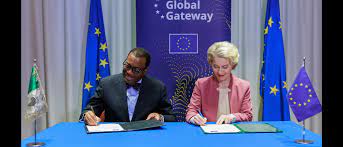The European Commission and the African Development Bank have signed a new framework agreement for their existing financial partnership, with Brussels hoping that the deal will give a boost to its Global Gateway infrastructure initiative in Africa.
The Commission aims to drive investment in projects and the EU initiative is considered Brussels’s alternative to China’s New Silk Road.
The partnership was recently renewed at the Italy-Africa summit in Rome. The exact amount of the funding framework was not disclosed, but the Commission said it has “significantly increased over the last two years, now amounting to €972 million in blending operations and guarantees.”
This agreement will enable a series of investments in strategic transport corridors, energy and digital connectivity south of the Sahara. One key joint project is the development of the Lobito Corridor, which will connect the Democratic Republic of Congo and Zambia to the Atlantic Ocean.
The route will run through Angola to the port of Lobito and connect the countries with the world markets from there. It is one of the typical projects competing with China, in this case, for access to raw materials.
The EU plans to invest around €150 billion in Africa between 2021 and 2027 as part of Global Gateway. That is half the planned €300 billion that it will invest around the world over the same period.
These headline figures are misleading, Wilhelm Emmrich of the foreign trade agency Germany Trade and Invest (GTAI) noted in conversation with Table. Media. The investments are expected to come largely from the private sector; with the EU securing the money through its investment guarantees.
Moreover, the EU will not be providing any new funds for the targeted investment amount by 2027. Instead, existing funding will be reallocated. This is because the EU’s multi-annual budget for 2021-27 had already been adopted before Global Gateway was launched.
While the private sector is expected to make an important investment contribution to Global Gateway, a report by Emmrich for GTAI reveals that there has hardly been any new funding to date.
Emmrich has examined the EU initiative’s list for 2024, which are labelled as lighthouse projects.
For 2023, ‘Team Europe’ has identified 87 lighthouse projects in five areas: digitalisation, climate and energy, transport, health and education and research. In December, the list of lighthouse projects was expanded by another 138 for 2024. Many projects have been running for years, while others are now being put out to tender for the first time.
As in the previous year, half of the 2024 lighthouse projects are in Africa. The report explains that with 30 projects, Latin America will replace Asia-Pacific (17 projects) as the second most important Global Gateway region in 2024. The EU has set an investment target of €45 billion for the region through 2027. The main sectors, both globally and in Africa, are climate and energy, followed by transport.
In addition to the specifically highlighted lighthouse projects, the EU initiative also includes other projects. However, Emmrich is critical of the lack of a list of these projects, or a uniform EU definition of which projects are included in Global Gateway and which are not.
The projects also cover a wide range, with a lack of focus: from supporting early childhood development to constructing hydroelectric power plants, to supra-regional programmes such as building submarine data cables and developing vaccine production in Africa.
However, the Global Gateway has generated an important change in Europe’s relationship with other world regions, Tim Zajontz from the University of Freiburg told Table. Media. Zajontz researches infrastructure projects and global political economy as part of the “De/Coloniality Now” project. He says that the EU is taking a more strategic and openly interest-led approach with Global Gateway than before.
Supporting extractivism
After two years of focusing on critical minerals, infrastructure, health and digitalisation, certain priorities can be discerned, says Zajontz. “The overarching geostrategic goal of the initiative is to secure access to certain resources, energy sources and markets and to reduce dependencies, especially on China.”
However, the focus on raw materials and the associated infrastructure could also become a problem. The EU consistently portrays its Global Gateway as a “better option” in international competition. However, critics point out that the initiative could continue the extractivism of the colonial era. The fact that the old European colonisers now claim that they want to protect Africans from the Chinese is often seen as hypocritical on the continent.
Indeed, a neo-extractivist race for African resources is in full swing, says Zajontz. However, the extent of the exploitation is not yet foreseeable. The countries of the Global South have become much more important and self-confident. It is now up to them to make demands on the Europeans. Zajontz also reports that some African politicians are even relieved that Europe is at least finally honouring its interest-driven policies.

